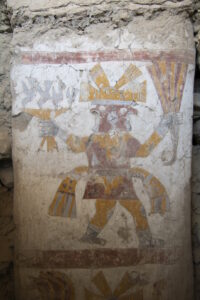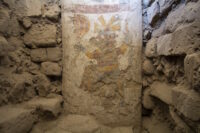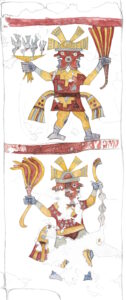 The excavation of the late Moche (c.600–850 A.D.) archaeological site of Pañamarca in northwestern Peru has uncovered two new murals painted on the adobe brick walls of an ancient architectural complex. They depict two two-faced individuals, one painted on the top, one on the bottom of a single adobe pillar in the hall.
The excavation of the late Moche (c.600–850 A.D.) archaeological site of Pañamarca in northwestern Peru has uncovered two new murals painted on the adobe brick walls of an ancient architectural complex. They depict two two-faced individuals, one painted on the top, one on the bottom of a single adobe pillar in the hall.
 Both two-faced figures are wearing headdresses or crowns and vividly colored clothing with large belts. They hold unusual items in their hands. The top one carries a goblet with four hummingbirds in one hand and feather fan in the other. The bottom man is waving a feather fan (unlike the rigid feathers of his neighbor’s fan, his feathers are captured in motion) and a stick-like object in his other. Damage to the painting makes it difficult to identify what it is.
Both two-faced figures are wearing headdresses or crowns and vividly colored clothing with large belts. They hold unusual items in their hands. The top one carries a goblet with four hummingbirds in one hand and feather fan in the other. The bottom man is waving a feather fan (unlike the rigid feathers of his neighbor’s fan, his feathers are captured in motion) and a stick-like object in his other. Damage to the painting makes it difficult to identify what it is.
 There is no known precedent for these figures in Moche art. They don’t have features typical of Moche deities — namely zoomorphic elements like fangs, claws, tails or wings. Archaeologists hypothesize that the two two-headed figures may have been an artistic exploration of depicting people (and feathers) in motion, so not two-headed monsters or gods, but men captured in blurred movement like two frames of animation in one panel. They may also be wearing masks.
There is no known precedent for these figures in Moche art. They don’t have features typical of Moche deities — namely zoomorphic elements like fangs, claws, tails or wings. Archaeologists hypothesize that the two two-headed figures may have been an artistic exploration of depicting people (and feathers) in motion, so not two-headed monsters or gods, but men captured in blurred movement like two frames of animation in one panel. They may also be wearing masks.
Constructed beginning in around 550 A.D., the Pañamarca architectural complex is richly decorated with murals that are unique iconographic testaments to Moche ritual, clothing, adornments and even to their trade links over long distances. Only an estimated 10% of the wall paintings at Pañamarca have been uncovered since the first  mural was discovered in 1958. The hall of pillars is particularly dense with these murals, and archaeologists still don’t know what the room’s purpose was, but it probably was not meant for public use because the passages are very tight and warren-like.
mural was discovered in 1958. The hall of pillars is particularly dense with these murals, and archaeologists still don’t know what the room’s purpose was, but it probably was not meant for public use because the passages are very tight and warren-like.
The Paisajes Arqueológicos de Pañamarca research project has been ongoing since 2018 under the joint leadership of an international team of archaeologists from Peru, Columbia University and the Denver Museum of Nature & Science. These murals were discovered during last year’s dig season. The summer 2022 dig aimed to document the stratigraphic phases of construction of the monumental temple complex and to excavate and conserve any murals encountered.
There is now a clearer throughline for Peruvian history and culture thanks to recent finds at Pañamarca and earlier ones made there during the past century. Digital photography, photogrammetric modeling, and virtual reality simulation will make these insights more widely available.
“Pañamarca was a place of remarkable artistic innovation and creativity, with painters elaborating on their knowledge of artistic canons in creative and meaningful ways as the people of Nepeña established their position in the far southern Moche world,” said Lisa Trever, Lisa, and Bernard Selz Associate Professor of Pre-Columbian Art History and Archaeology at Columbia University.